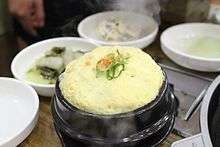Ttukbaegi
A ttukbaegi (뚝배기) is a type of oji-gureut,[1] which is an onggi coated with brown-tone ash glaze.[2][3][4] The small, black to brown earthenware vessel is a cookware-cum-serveware used for various jjigae (stew), gukbap (soup with rice), or other boiled dishes in Korean cuisine. As a ttukbaegi retains heat and does not cool off as soon as removed from the stove, stews and soups in ttukbaegi usually arrive at the table at a bubbling boil.[5]
| Ttukbaegi | |
 Two jjigae (stew) served in ttukbaegi | |
| Korean name | |
|---|---|
| Hangul | 뚝배기 |
| Revised Romanization | ttukbaegi |
| McCune–Reischauer | ttukpaegi |
| IPA | [t͈uk̚.p͈ɛ̝.ɡi] |
History
The Ttukbaegi dates from the Goryeo Dynasty and has been widely used from the Joseon Dynasty up to the present day. In the Goryeo-period poem "This month" (이달충), the phrase "White-makgeolli is brought to the Ttukbaegi" indicates the existence and common use of Ttukbaegi.[6]
Kinds
The ttukbaegi can be classified according to the production process and usage.
Classification according to production process
- Oji ttukbaegi(오지 뚝배기):The 'Oji' of the Oji bowl refers to the bowl of '오자기'(烏 瓷 器) which is of a solid black color. The pottery is heated with lye, which is a natural glaze, is already found in the Gaya period and early Silla period.[7]
- Jil ttukbaegi(질 뚝배기): The 'Jil ttukbaegi' is not coated with lye. This ttukbaegi can be considered to be almost the same as the ancient earthenware.[8]
Idioms
As ttukbaegi is considered a crude pottery, people use the proverb "Soybean paste stew tastes better than a ttukbaegi looks. (Ttukbaegiboda jangmasi jota; 뚝배기보다 장맛이 좋다.)"[9] to say that you shouldn't prejudge the content by the humble outward appearance.[1]
Gallery
 Sundubu-jjigae served in ttukbaegi
Sundubu-jjigae served in ttukbaegi Kimchi-jjigae still boiling in ttukbaegi
Kimchi-jjigae still boiling in ttukbaegi Gyeran-jjim boiled and fluffed in ttukbaegi
Gyeran-jjim boiled and fluffed in ttukbaegi
References
- (in Korean) "ttukbaegi" 뚝배기 [stone pot]. Standard Korean Language Dictionary. National Institute of Korean Language. Retrieved 1 March 2017.
- Suh, Cheong-Soo; Rowan, Bernard; Cho, Yoon-jung, eds. (2004). An Encyclopaedia of Korean Culture (English ed.). Seoul: Hansebon. p. 41. ISBN 9788995135242.
- Lee, Jin-hyuk; Mouat, Colin A. (2014). Korean Handicrafts: Art in Everyday Life. Seoul: Seoul Selection. ISBN 9788997639540.
- Kim, Yong-ho; Lee, Yu jin (2014). "A study on the chronology of Joseon period 'onggi' found in mid-western area" (PDF). Archaeological Studies of Science and Technology. Ajou University Museum of Tools. 20: 109.
- Pettid, Michael J. (2008). Korean Cuisine: An Illustrated History. London: Reaktion Books. p. 57. ISBN 978-1-86189-348-2.
- (사)한국전통주진흥협회.
- "오지그릇 - 한국민족문화대백과사전". encykorea.aks.ac.kr (in Korean). Retrieved 2018-04-07.
- "e뮤지엄".
- Koehler, Robert (2010). Lee, Jin-hyuk; Mouat, Colin A. Mouat (eds.). Traditional Food: A Taste of Korean Life. Seoul: Seoul Selection. ISBN 9788991913769.

